Looking for seriously fun science, technology, engineering, and maths news for your curious kids or tech-talented teens? We've got you covered! Inside every issue you'll find articles, activities, puzzles, comics, and prizes galore. Perfect reading for enquiring minds, CSIRO's Double Helix magazine is packed with news, features, fun experiments, giveaways and more. Each issue focuses on a different theme, from smells to spaceships and beyond! With clear language and eye-catching design, the content promotes critical thinking, strengthens literacy skills and is the perfect fuel to spark or sustain an interest in STEM. Double Helix is published eight times a year. It is ideal for 8 to 13-year-olds and enjoyed by older readers as well.
ON THE COVER
Double Helix
HELIX HQ
ON THE DOUBLE
WHY FROGS DON’T GET POISONED
'ZOMBIE-FINGER' FUNGUS HANGING ON
FROST FEATHERS
HEALTHY EATING, BIRD-STYLE
HOPE ROARS
JACKALS’ MELON VINE
HIGH-RISE FLYERS
BY THE NUMBERS: THE MIGHTY WOLLY!
SWEET NEWS FOR FRUIT BATS
DOLPHIN DIALECTS
GAME ON!
SUBSCRIBE
TWIRL, TWIRL MAGNETIC STAR
IO: THE ETERNAL INFERNO
SWEAT: A NEW POWER SOURCE?
3D SCANS SOLVE DINO DILEMMA
CURING A CROCODILE BITE • Nyikina Mangala People have used mudjala bark from mangroves as medicine for many generations. The bark can be used to clean wounds and relieve pain. It has even been used to help heal crocodile bites!
Sounding out invasives • Close your eyes and imagine the sounds of a forest – birdsong, flowing creeks, rustling leaves. Listening to these sounds is like checking nature’s pulse. But it can also reveal invasive species.
THE TIDE IS TURNING • Good news travels fast, and this is so cool, we should be shouting it from the rooftops! Twenty-nine animal species that were at risk of potential extinction have recovered to the point where they’re no longer listed as threatened under Australia’s national environment laws.
LIVING FOSSIL • Since life first began on Earth around four billion years ago, more than 99 per cent of all species that ever lived have disappeared. Yet some species have managed to stick around, surviving unchanged for an extremely long time. We call these living fossils.
POSTER
How to Save the Whole Blinkin’ Planet
First Woman: NASA’s Promise for Humanity
TIME-TRAVELLING SHED
VILE VENUS • HI THERE, EARTHLINGS. GAIL LEXY HERE WITH NEWS ABOUT VENUS, YOUR NASTY NEIGHBOUR.
FROM DNA TO DE-EXTINCTION • DNA carries the instructions for life, and every animal has its own DNA code. Now, scientists are using DNA to protect animals…and maybe even bring extinct animals back!
BACK OF THE ENVELOPE
WHAT’S YOUR QUESTION?
THE LIBRARY
TAKE ON CITIZEN SCIENCE • BE THE EYES AND EARS OF SCIENCE. BE A CITIZEN SCIENTIST!
BUBBLE NETS • IF YOU THOUGHT HUMANS WERE THE ONLY FISHERS WHO USE NETS, THINK AGAIN! HUMPBACK WHALES WORK TOGETHER TO NET AND HERD FISH, MAKING THEM EASIER TO CATCH AND EAT. BUT INSTEAD OF ROPE OR FISHING LINE, THESE NETS ARE MADE OF BUBBLES! TO LEARN MORE, IT’S TIME TO BLOW SOME BUBBLE NETS OURSELVES.
MAKE A PIT TRAP • MEET YOUR BACKYARD CREEPY CRAWLIES! SCIENTISTS OFTEN USE THESE SIMPLE TRAPS TO SEE WHAT INSECTS LIVE NEARBY.
MAKE IT LISTENUP
WHO MESSED UP THE LAB?
PUZZLES
PRIZES

 Issue 77
Issue 77
 Issue 76
Issue 76
 Issue 75
Issue 75
 Issue 74
Issue 74
 Issue 73
Issue 73
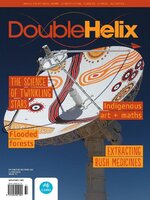 Issue 72
Issue 72
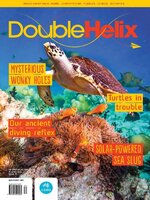 Issue 71
Issue 71
 Issue 70
Issue 70
 Issue 69
Issue 69
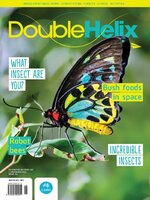 Issue 68
Issue 68
 Issue 67
Issue 67
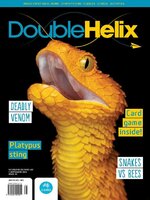 Issue 66
Issue 66
 Issue 65
Issue 65
 Issue 64
Issue 64
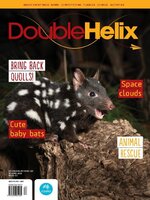 Issue 63
Issue 63
 Issue 62
Issue 62
 Issue 61
Issue 61
 Issue 60
Issue 60
 Issue 59
Issue 59
 Issue 58
Issue 58
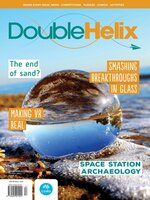 Issue 57
Issue 57
 Issue 56
Issue 56
 Issue 55
Issue 55
 Issue 54
Issue 54
